New world screwworm info shared with beef industry before public announcement

Some in the cattle industry were shocked when Reuters reported a human case of new world screwworm on Aug. 24, 2025.
Some cattle industry participants apparently were not surprised with the news. Cassandra Garrison, Tom Polansek and Leah Douglas reported for Reuters that Beef Alliance (an organization of some of the nation’s largest corporate cattle feeders) had emailed about two dozen people in the “livestock and beef sectors, informing them that the Center for Disease Control had confirmed a human case of screwworm in Maryland in a person who had traveled to the U.S. from Guatemala,” according to an anonymous source.
The Beef Alliance sent two different emails to select industry participants on Aug. 20, 2025, said an anonymous source.
The second email said the CDC is required to report the case to both the Maryland state public health official and the Maryland State Veterinarian. “The CDC also notified Beltway agriculture stakeholders of the positive human new world screwworm case,” said the email.
The second email from the Beef Alliance also told recipients that Health Insurance Portability and Accountability Act prevents information including legal status about the patient from being made public. The email said, “it is unclear whether there will be any press coverage” and that because awareness “is currently limited to industry representatives and state veterinarians,” the market impact should be minimal.
The first email said, “Colin shared that he has reached out to David Anderson at Texas A and M University to request an industry impact report on the effects of the border closure on both the cattle industry and consumers.” According to the email, the report will be designed for USDA Secretary Brooke Rollins and her team by being concise, easily digestible and will be produced expeditiously.
The Beef Alliance’s website says its members are recognized as “progressive and innovative leaders in the U.S. cattle feeding segment” and that the organization represents about one-third of the fed cattle supply.
Beef Alliance members listed on the website are: Adams Land and Cattle, Agribeef, Beef Northwest Feeders, Biegert Group, Cactus Feeders, Five Rivers Cattle Feeding, Friona Industries, Innovative Livestock Services and La Vaca Cattle Co., Inc.
A call to Don Gales of Friona Industries, who serves as the Beef Alliance Chairman, was not returned.
A CDC spokesman, Nicholas Spinelli said that the CDC, in coordination with the Maryland Department of Health, investigated a confirmed case of travel-associated new world screwworm in a patient who returned from travel to El Salvador. The case was confirmed by CDC through telediagnosis (i.e., expert review of submitted larvae images) on Aug. 4, 2025. “This is the first human case of travel-associated new world screwworm myiasis (parasitic infestation of fly larvae) from an outbreak-affected country identified in the United States. Currently, the risk to public health in the United States from this introduction is very low,” Spinelli said.
CDC did not respond to questions about the discrepancy over which country the person had been in.
INDUSTRY RESPONSE
Billings-based cattle producer group R-CALF USA said that the Beef Alliance’s inside knowledge of the human case of new world screwworm indicates a “broken governmental system.”
“We are deeply concerned that if the publicly disseminated Reuters Report is accurate, including its implication that only select industry participants were timely informed of the detection of this devastating pest in the United States, then our governmental system is fundamentally broken,” said the organization in a published statement.
“If a human case of new world screwworm was confirmed on or about Aug. 20, and if that fact was secretly disseminated to only a select group of industry insiders, but not simultaneously shared with all organizations representing independent livestock producers… then we ask for a full investigation of this incident and the establishment of a new world screwworm task force…” said the R-CALF USA news release.
R-CALF USA has been critical of what they consider a cozy relationship between USDA, corporate agricultural entities and large organizations whose policies align with corporate interests.
In response to a request for an interview, National Cattlemen’s Beef Association’s communications representative shared the following statement from CEO Colin Woodall in an Aug. 26, 2025 email: “NCBA is aware of a new world screwworm case detected in a person traveling from abroad into Maryland. The case was quickly identified and handled by the CDC in accordance with their protocols. Based on what has been shared with state animal health officials, we do not see any elevated risk to the livestock industry at this time. We appreciate the diligence of human health authorities. This case was quickly addressed thanks to existing protocols and we are thankful for the ongoing coordination between the CDC, state departments of health, state animal health officials, and USDA.”
STATE VETERINARIANS
State veterinarians said that the information shared with them was not meant for public consumption.
New Mexico State Veterinarian Samantha Holick confirmed that she was made aware of the human case of NWS on Aug 19, 2025, in a call with the National Assembly of State Animal Health Officials. The CDC briefly joined the call to share basic details of the case with the state vets.
Holick said that because it is a human case, it is “outside the realm of USDA” and that USDA didn’t make any information available.
The limited information shared with the state veterinarians indicated that the case had been resolved and that “there was no ongoing concern” Holick said. “If there had been bigger risk factors, we would have convened a meeting right away,” she said.
Holick said that the revelation of the human case of NWS to state veterinarians is not considered a public announcement. If she had shared that news with anyone, it would have been inter-agency, not with the public. “The information that was divulged to us was pretty general. Anybody who is in the human realm understandably has to take a lot of precaution with anything that is shared so they don’t violate any personal rights. That’s really CDC’s information to distribute as they see appropriate,” she said.
Holick stressed that this is not the first human case of NWS, pointing out that the last one was a year or two ago. A joint USDA and HHS news release said that several isolated human cases in recent years have not resulted in transmission to livestock.
The state veterinarians were informed that healthcare professionals properly disposed of the larvae from the infested person and that case is understood to be isolated, and that no additional risk to livestock or pets is known.
No imminent danger to livestock exists due to this case, Holick said. “I wouldn’t recommend changing anything that they (livestock producers) are doing currently. I think for all of us, being diligent with our management practices of continuing to take good care of our livestock, that’s the key with any risk.”
North Dakota State Veterinarian Ethan Andress said it is common for state veterinarians to be provided information that is not meant to be made public.
Andress said in human cases such as this one, the CDC is the agency that oversees the situation and disseminates the information rather than USDA. “The standard protocol on all of those situations just like this one with the CDC and USDA is just that they share information with us, but that information is ‘siloed’ that they share in confidence. It is their responsibility to put that information out,” he said. “It’s not unusual for us to have confidential information that we sit on for a day or two or maybe a week,” he said.
“This would be outside of USDA’s lane, so they aren’t going to comment on CDC activities. That’s standard protocol. They wouldn’t step out in front. I’m not sure why it was held so close to the chest, I assume there were concerns about markets and creating fear in the market,” said Andress. He said government agencies including USDA do not tend to communicate quickly with state veterinarians. He said this might be due in part to the transition to a new administration, but that it has been an age-old problem.





